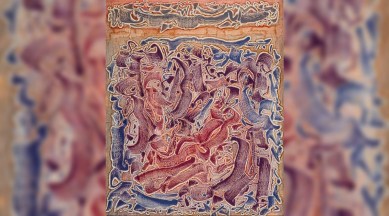📣 For more lifestyle news, click here to join our WhatsApp Channel and also follow us on Instagram
Ambadas at 100: An exhibition celebrates the modernist’s centenary
On his birth centenary, an exhibition pays tribute to Ambadas Khobragade – one of the most significant masters of abstract art

“When Ambadas paints, he goes into a trance,” Hege Backe, wife of famed modern and contemporary painter Ambadas Khobragade had once told Roobina Karode, Head Curator of the Kiran Nadar Museum of Art. “It is almost like he is dancing. Once he starts painting, he cannot stop for as long as it takes until his work is finished, or the energy will be lost,” she had said. This fluidity of creation is what gives Khobragade’s art its characteristic self-generative energy that is likely to not be emulated by any other artist.
In the spirit of keeping Ambadas Khobragade’s legacy alive, an exhibition titled “Celebrating Ambadas” has been curated in collaboration between Ushaarth Art Gallery and Dhoomimal Gallery at India International Centre till June 27. Curated by art collector Shruti Lakhanpal Tandon in association with art critic Prayag Shukla, the exhibition opened on June 16 in time for Khobragade’s centenary on July 1. It was prompted by a conversation between Backe and Shukla, who had also been one of Khobragade’s close friends, wherein Backe wondered if everyone had forgotten Ambadas – a modernist who has not received widespread attention in the mainstream media.
monthly limit of free stories.
with an Express account.
At the Kamaladevi Complex in the IIC, visitors are surrounded by Khobragade’s characteristic vibrant colours and abstract strokes, next to walls adorned with important contextual details about his life and work. In her inaugural address during the opening ceremony, Karode shared anecdotes from her time spent with Khobragade and his Norwegian wife at their home in Oslo while researching for her biography on the artist.
Karode points out that his earlier works tend to represent a form of division or crossroads, implying the existence of stark binaries – while his later works include denser meanderings with limited endings and beginnings. “His paint strokes reflect the way that Ambadas himself moves in the world, disoriented and meandering,” Karode adds.
Though Ambadas rarely titled his works, they can be distinguished based on their medium and technique. After a stint working at the Vikram Toy Factory in Mumbai, he learned to use the incompatibility of oil and water in painting: he would dilute his oils to paint on the canvas, creating the unique texture of his ribbon-like strokes. This features most prominently in his painting series “Roop Bhed”, a centrepiece of the exhibition. When using watercolours, he would drop coloured paint onto wet paper and let it float until it created a pattern of its own. The body of the paint would evaporate and leave only its mark behind. His untitled series of watercolours from 1975 represent this technique most clearly. He explored the disembodied nature of his art, allowing it to take its own form instead of using the canvas as a way to showcase his own skills.
Khobragade, born in Telegaon in Maharashtra, was the youngest of six children in a family that often struggled to make ends meet. He would often accompany his father on a bullock cart and deliver fruit to neighbouring towns, spending his time staring at the night sky and letting his imagination run wild. Once his family moved to Akola, Khobragade befriended social worker Kanu Mashruwala, whose sister was married to Manilal, Mahatma Gandhi’s son. This friendship put him in touch with the rest of the extended Gandhi family, heavily influencing him with the Gandhian philosophy.
The Mashruwala family helped Khobragade study under Ravishankar Raval in a private art school in Ahmedabad, but he quickly figured out that his strengths lay outside the realm of traditional art conventions. He struggled with drawing human figures and landscapes, even after being admitted to the Sir JJ School of Art in Mumbai, where he felt suffocated by the strict curriculum of art classes. This would mark a turning point for Khobragade’s career, as he realised that he could not conform to realist art styles and declared himself an abstractionist.
He received a stipend from JJ School, which allowed him to remain a student, and spent the consequent years experimenting with his art by breaking the conventions he had been taught and questioning the existence of form. He learned from teachers like Shankar Palsikar, and his peers Tyeb Mehta, Mohan Samant, J Swaminathan, and Akbar Padamsee. The rapidly growing expressionist movement abroad, driven by the brutalities of war and colonisation seen during the time, also played an important role in influencing his abstractionism.
To Khobragade, a painting was not something to be controlled. The esoteric nature of his art has invited speculation and analysis from everyone who has seen it, with no right or wrong answers.
“Celebrating Ambadas” includes curatorial walks in collaboration with schools and societies across Delhi NCR, poetry readings, and an interview-documentary screening on the artist’s life and works.
📣 For more lifestyle news, follow us on Instagram | Twitter | Facebook and don’t miss out on the latest updates!
📣 For more lifestyle news, click here to join our WhatsApp Channel and also follow us on Instagram